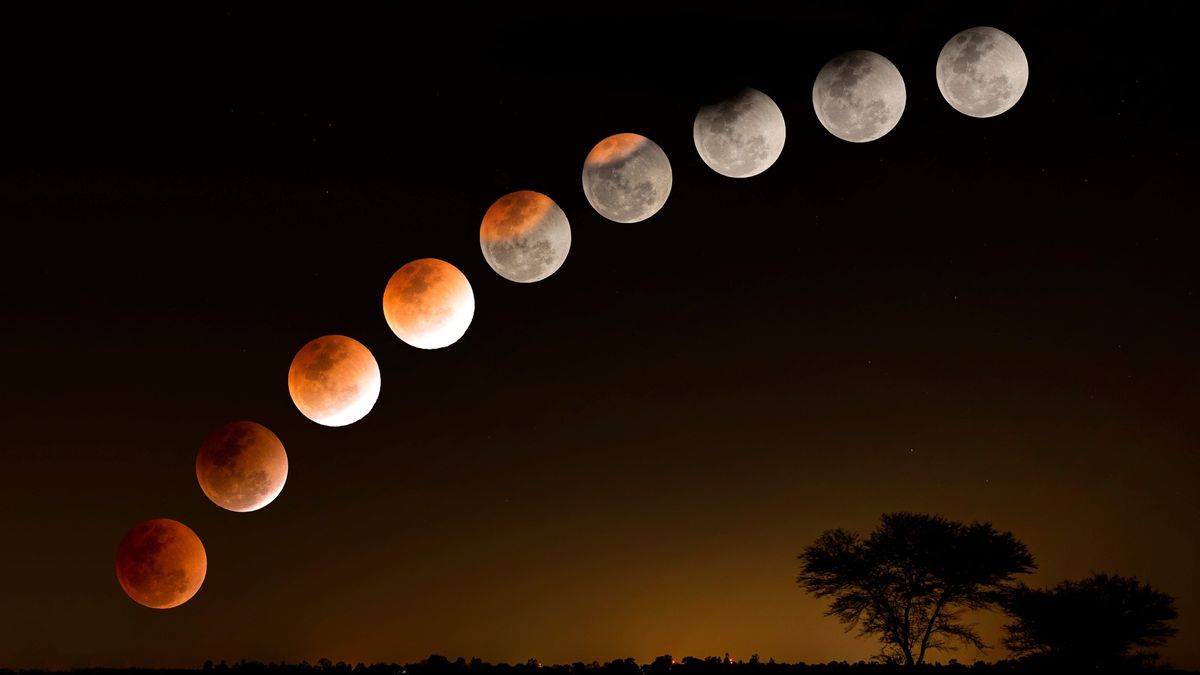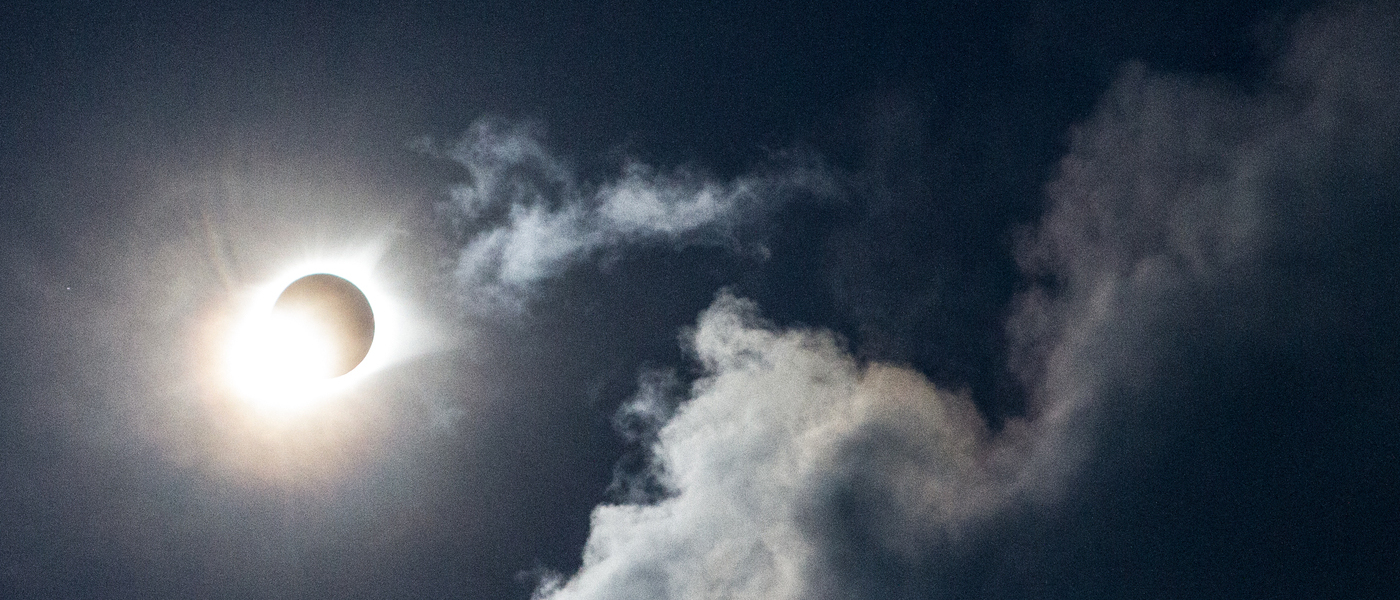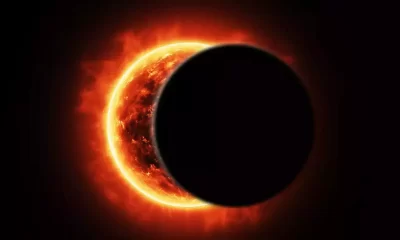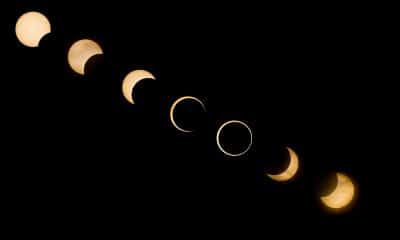Science
How To Tell If You Have Eye Damage After Viewing The Eclipse

Eye balls bugging you after watching the eclispe? The solar eclipse passed over Mexico, the United States, and Canada on Monday, providing a heavenly show. However, in the aftermath, some people may experience eye irritation instead of astonishment.
You may be wondering if your eclipse glasses were bogus. Perhaps you neglected to put them back on as the day’s first rays arrived after totality. Or you spotted your child, friend, or family member looking up at the sun without wearing glasses.
How To Tell If You Have Eye Damage After Viewing The Eclipse
Solar retinopathy, or retinal damage brought on by solar radiation, can result from looking at the sun without using appropriate eye protection, such as certified eclipse glasses or solar viewers. While the highly specialized cells inside our eyes do not experience pain, staring at the sun causes inflammation and damage to the rods, cones, and photochemical reactors, according to Ronald Benner, an optometrist and president of the American Optometric Association.
During the 2017 total solar eclipse, a young woman was diagnosed with solar retinopathy in both eyes after viewing it with eclipse glasses that physicians said were not up to safety standards.
There is no cure for solar retinopathy. It may improve or worsen, but it is a permanent condition.
After-eclipse eye injury symptoms
Symptoms of eye injury from viewing the eclipse without proper protection can take hours or days to appear. They include loss of central vision, changes in color vision, and distorted vision.
How To Tell If You Have Eye Damage After Viewing The Eclipse
“Eclipse damage is unlikely to produce pain or discomfort in your eyes because the retina lacks pain nerves. Instead, visual symptoms might appear within 4-6 hours. However, some people may experience symptoms after 12 hours,” emailed Michelle Andreoli, eye ophthalmologist and clinical representative for the American Academy of Ophthalmology.
Doctors advise that if you detect any signs or are experiencing eye discomfort, schedule an appointment with a health care provider or an eye care specialist right away.
“For most people, it’s an alteration of color vision,” he stated. “The next morning, the colors don’t appear right, or they’ve been bleached out or fuzzy all the time. Others may have genuine holes in their vision.
According to Benner, damage to the center of someone’s eyesight can impair their ability to read or recognize faces.
It is comparable to the effect a camera flash has on our eyes, which can distort it for a few minutes before going away. However, the severity of solar retinopathy causes lifelong damage that is not immediately noticeable. Overnight, the cells can perish and will not be replaced.
How To Tell If You Have Eye Damage After Viewing The Eclipse
The injury sustained determines the alterations in a person’s vision, which can occur in one or both eyes.
“The retina is an extension of the brain, so it’s actually neurological tissue, and when you damage that, it doesn’t always come back,” he said. “If you harm one cell, it may never be the same. However, if you damage a group of cells, you will experience blotchy vision, similar to having someone rub oil on your windshield. If you only cause little damage to them and do not kill them, their color vision will be affected. What can you do about this? Nothing else than preventing it.”
Benner also recommends that parents discuss with their children the signs of pain if they watched the eclipse together, especially if they are concerned that their children may have removed or glanced around the eclipse glasses. Children may find it difficult to explain their experiences, such as not being able to properly see
SOURCE – (CNN)
Science
Canadian Researchers Look to Plants for Bacterial Infections

Canadian researchers are exploring novel techniques with plants to address major difficulties caused by bacterial infections, such as using antibacterial plants to control bacteria in poultry meat.
Antibiotics have been routinely used in poultry farming to prevent and treat bacterial infections. Antibiotic overuse has resulted in the rise of antibiotic-resistant microorganisms, endangering both animal and human health.
This has pushed scientists to investigate alternative methods of controlling bacterial infections in chickens, Agrinews Group reports.
Researchers in Canada are investigating the antibacterial properties of native plant extracts. Rumex and Potentilla are two distinct plants that have proven potential.
These plants are being studied for their effectiveness in battling bacterial infections such as Avian Pathogenic E. coli (APEC), a common cause of chicken sickness.
Rumex and Potentilla fight bacterial infections.
Dr. Sophie Kernéis-Golsteyn, a microbiologist at Lethbridge Polytechnic in Alberta, leads a 2.5-year Egg Farmers of Canada program.
Since 2016, her team has been testing native plants for antibacterial properties, collecting 150 samples. Rumex and Potentilla extracts are highly effective at protecting chickens from bacterial diseases.
These plants’ antibacterial properties are attributed to their ability to increase beneficial microbiota and stimulate the production of digestive enzymes. These botanical extracts reduce inflammation, strengthen the immune system, and improve overall productivity in poultry.
The use of antimicrobial flora in avian husbandry has many benefits. First, it reduces reliance on antibiotics, lowering the danger of antibiotic resistance.
Furthermore, it improves chicken health and well-being by boosting their immune response and digestive function. Finally, it aligns with client preferences for organic and sustainable agriculture practices.
While the potential benefits are significant, there are some drawbacks to consider. The efficiency of plant extracts may vary based on factors such as extraction technique, dosage, and the bacterial strains involved.
Furthermore, more research is required to fully understand the long-term impacts of using these plants in poultry production. The study of antimicrobial plants for bacterial control in chickens is a promising field of research in Canada.
Researchers are looking for effective and sustainable alternatives to antibiotics. One strategy is to leverage the natural properties of plants such as Rumex and Potentilla. This strategy reduces antibiotic resistance and improves the overall health and productivity of chicken farms.
Related News:
Mexico Wants US To Finance 4 Wind Power Plants
Science
Australia Asks Residents to Catch Deadly Funnel Web Spider

As summer approaches in Australia, residents are warned to look out for the funnel web spider, one of the country’s deadliest species.
In addition to advising the public to avoid funnel-web spiders during mating season, the Australian Reptile Park in New South Wales has even asked people to capture live funnel-web spiders so they can “milk” their venom.
Native to eastern Australia, the funnel web spider can kill humans in as little as fifteen minutes if they do not receive medical treatment for its poisonous bite.
There have been thirteen fatalities attributable to this species, but none since the development of antivenom in 1981. The Australian Reptile Park is appealing to the public for assistance capturing and donating spiders, as the serum relies on milking live spiders.
Hunting for the funnel net spider in residential areas is common practice after a particularly wet and warm season. Look for spiders in cool, dark places like pools, garden residue, heaps of dirty clothing, and outside shoes.
Australian Reptile Park spider keeper Emma Teni recently blogged about how they rely on spider donations more than ever, especially now that breeding season has arrived and the temperature is perfect.
“Male funnel-web spiders have short lifespans, and with approximately 150 spiders required to make just one vial of antivenom, we need the public’s help to ensure we have enough venom to meet demand.”
“If you spot an egg sac while collecting a spider, it’s important to safely collect that as well,” said Teni. “It can provide a robust supply of healthy young spiders to aid in our antivenom production.”
The spiders won’t be able to climb plastic or glass, but Teni suggests capturing funnel webs in a wide-mouthed jar with a cover. Then, you can lead the spiders into the container using a long spoon or something similar.
After that, fill the jar with moist soil, screw on the top, and bring it to the designated drop-off spot.
“We depend on the public for spider donations, and we want to make sure everyone stays safe during the collection process, especially with conditions being so favourable this year,” said Teni.
Related News:
Trudeau Orders Facebook to Block Presser Video from Australia
Science
A Spacecraft Is On Its Way To A Harmless Asteroid Slammed By NASA In A Previous Save-The-Earth Test

CAPE CANAVERAL, Florida – A spacecraft launched Monday to probe the site of a cosmic accident.
The European Space Agency’s Hera spacecraft launched on a two-year trip to the little, harmless asteroid slammed by NASA two years ago as a practice run for the day when a murderous space rock threatens Earth. It’s the second phase of a planetary defense experiment that could one day save the globe.
SpaceX’s Falcon rocket vanished with Hera into the late morning clouds. An hour later, cheering erupted in the control center in Germany as the spacecraft split from the rocket’s upper stage and returned home. “It’s an amazing day,” the space agency’s director general, Josef Aschbacher, said later.
The 2022 crash of NASA’s Dart spacecraft reduced Dimorphos’ orbit around its larger companion, indicating that if a harmful rock was heading our way, it might be pushed off course with adequate warning.
nasa
A Spacecraft Is On Its Way To A Harmless Asteroid Slammed By NASA In A Previous Save-The-Earth Test
Scientists are eager to analyze the aftermath of the impact up close to determine how effective Dart was and what improvements may be required to protect Earth in the future.
“The more detail we can glean the better as it may be important for planning a future deflection mission should one be needed,” University of Maryland astronomer Derek Richardson stated before launch.
Researchers want to know if Dart (short for Double Asteroid Redirection Test) created a crater or changed the 500-foot (150-meter) asteroid more dramatically. It seemed to be a flying saucer before Dart’s blow and may now resemble a kidney bean, according to Richardson, who participated in the Dart mission and is assisting Hera.
Dart’s wallop sent rubble and boulders hurtling off Dimorphos, adding to the impact’s momentum. For months, the debris track extended thousands of miles (almost 10,000 kilometers) into space.
According to flight director Ignacio Tanco, some rocks and debris may still be hovering about the asteroid, posing a threat to Hera.
A Spacecraft Is On Its Way To A Harmless Asteroid Slammed By NASA In A Previous Save-The-Earth Test
“We don’t really know very well the environment in which we are going to operate,” Tanco informed me. “But that’s the whole point of the mission is to go there and find out.”
European authorities refer to the $400 million (363 million euros) effort as a “crash scene investigation.”
“Hera is going back to the crime scene and getting all the scientific and technical information,” said project manager Ian Carnelli.
Carrying a dozen science instruments, the compact car-sized Hera must swing past Mars in 2025 for a gravitational boost before landing at Dimorphos by the end of 2026. It’s a moonlet of Didymos, the Greek word for twin, a five-times larger asteroid that spins quickly. At that point, the asteroids will be 120 million miles (195 million kilometers) from Earth.
Hera will attempt to enter orbit around the rocky duo, progressively reducing flyby distances from 18 miles (30 kilometers) to a half-mile (1 kilometer). The spacecraft will examine the moonlet for at least six months to determine its mass, shape, composition, and orbit around Didymos.
Before the crash, Dimorphos circled its larger partner from three-quarters of a mile (1,189 meters) away. Scientists believe the orbit has become tighter and more oval-shaped, and that the moonlet may be tumbling.
Two shoebox-sized Cubesats will launch from Hera for even closer drone-like examinations, with one employing radar to peek beneath the moonlet’s boulder-strewn surface. Scientists believe Dimorphos was produced from particles shed by Didymos. The radar measurements should assist in determining whether Didymos is the small moon’s parent.
A Spacecraft Is On Its Way To A Harmless Asteroid Slammed By NASA In A Previous Save-The-Earth Test
After their survey, the CubeSats will attempt to land on the moonlet. If the moonlet tumbles, the situation will become more complicated. Hera may potentially conclude its mission with a perilous touchdown but on the bigger Didymos.
Asteroids, which are remnants of the solar system’s origin 4.6 billion years ago, circle the sun principally between Mars and Jupiter in what is known as the main asteroid belt, where millions of them live. When they fall from the belt and land in our area, they become near-Earth objects.
NASA now has around 36,000 near-Earth objects, the majority of which are asteroids, although there are also some comets. More than 2,400 of them are deemed potentially dangerous to the Earth.
SOURCE | AP
-
Politics4 weeks ago
Miller Expects 4.9 Million Foreigners to Leave Canada Voluntarily
-
News4 weeks ago
Nolinor Boeing 737 Crash Lands in Montreal
-
News3 weeks ago
“Shocking Video” Vancouver Police Shoot Armed Suspect 10 Times
-
Tech4 weeks ago
Increasing its Stake in OpenAI by $1.5 Billion is a Possibility for SoftBank.
-
Tech4 weeks ago
Canadian Media Firms Are Suing OpenAI in a Potential Billion-Dollar Dispute.
-
Finance2 weeks ago
Chrystia Freeland Promises Mini-Budget By Dec 16th





























